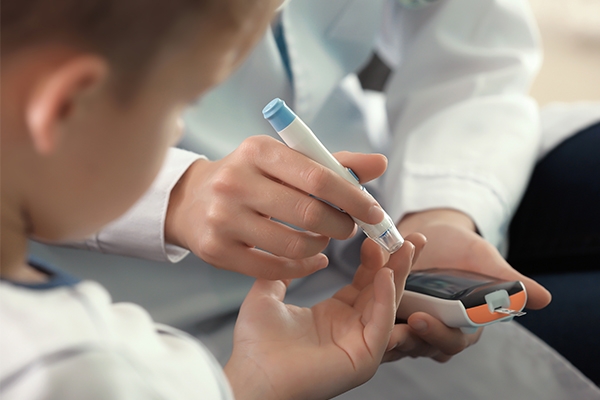Diabetes Basics You Should Know

Diabetes is one of the world's ten deadliest diseases. According to the World Health Organization (WHO), the number of diabetics in Indonesia will reach 30 million by 2030!
Carbohydrates are found in the foods we eat. Carbohydrates are broken down by the body into their most basic form, glucose. Glucose is used as an energy source by body cells. When glucose levels in the blood rise, the insulin hormone produced by the pancreas is in charge of keeping them stable.
However, some people's bodies are unable to produce or use insulin properly. As a result, the sugar level in the blood rises. This is known as diabetes.
Diabetes types
Diabetes is classified into three types:
1. Type 1
This type of diabetes occurs when the pancreas produces no or very little insulin. The cause is unknown.

However, genetic factors are suspected to be to blamed. To survive, people with type 1 diabetes must inject insulin every day.
2. Type 2
This type of diabetes occurs when the body's cells become less sensitive to insulin (insulin resistance). The most common cause is a poor diet and an unhealthy lifestyle.

Insulin will attempt to balance the amount of sugar consumed. When sugar consumption is excessive, the pancreas is unable to produce enough insulin. As a result, glucose levels in the blood rise. Other factors include a family history of diabetes and having been diagnosed with gestational diabetes.
3. Gestational diabetes
This type of diabetes is experienced by pregnant women due to hormonal changes. However, it usually goes away after the baby is born. During pregnancy, the body produces various hormones.

Increased hormone levels inhibit insulin's ability to process blood sugar. Other causes include being overweight, being over 25 years old, having a genetic history of diabetes, and having the hormone disorder polycystic ovary syndrome (PCOS).
There is also the condition known as prediabetes. When blood sugar levels are elevated but not high enough to be diagnosed with type 2 diabetes. If untreated, prediabetes puts a person at risk of developing type 2 diabetes.
Recognize the diabetes symptoms
Polyuria (frequent urination), polydipsia (frequent thirst), and polyphagia (eating a lot or being hungry easily) are the three most common symptoms of diabetes.
Weight loss, blurred vision, fatigue, numbness or tingling in the hands and feet, dry skin, and wounds that heal slowly or do not heal are other symptoms.
Diabetes type 1 can strike at any age. It could take months or years to become aware. Adults are frequently affected by type 2 diabetes symptoms. A doctor's test is also required to determine whether you have gestational diabetes, which can be performed as early as the 24th week of pregnancy.
There are also gender-specific symptoms. Erectile dysfunction and decreased sexual drive can occur in men. In women, there may be signs of urinary tract infection and dry genitals.
Diabetes prevention
Until now, no one knew how to prevent type 1 diabetes. Early detection expedites treatment and management.

Maintain a healthy lifestyle to avoid type 2 diabetes. Drop some pounds if you're overweight. Consume nutritious and healthy foods. Reduce your saturated fat consumption! Running, brisk walking, or a workout for at least 150 minutes per week is most appropriate and comfortable.
A history of gestational diabetes can lead to type 2 diabetes. After the baby is born, the mother's condition will improve. Sugar levels have returned to normal. However, approximately 50% of women with gestational diabetes may develop type 2 diabetes!
How can you avoid it? After giving birth, strive to achieve your ideal body weight. 6-12 weeks after the baby is born, perform a blood sugar test. Type 2 diabetes is possible if the glucose level in the blood remains high. If the blood glucose level is normal, a blood test every three years is required to determine the possibility of type 2 diabetes.
There is no known prevention for gestational diabetes. However, some recommendations can be made, such as eating nutritious foods, maintaining a healthy body weight prior to pregnancy, and participating in sports.
How to diagnose diabetes
The longer a person goes without being diagnosed and treated for diabetes, the worse their health will become.
Diabetes is diagnosed through blood sugar tests such as:
- Random plasma glucose test. Can be done at any time and on your own. Using a glucometer, for example. If you find out that your blood sugar levels reach 200 mg/dL or higher, see your doctor.
- The fasting plasma glucose (FPG) test. It uses blood samples that are taken after fasting overnight (approximately 8 hours). Prediabetes may be diagnosed if the test result is between 100 and 125 mg/dL. And diabetes may be diagnosed if the results show 126 mg/dL (7 mmol/L) or higher.
- The A1C test. A test that displays the average blood sugar level over the previous few months (2–3 months). If the result is 6.5% or higher and is repeated, diabetes may be present. Meanwhile, test results ranging from 5.7 to 6.4% indicated prediabetes.
Aside from the three tests mentioned above, there are three more: an oral glucose tolerance test, a 2-hour postprandial blood sugar test, and a C-peptide insulin test.
Diabetes causes other health issues
Diabetes patients are more likely to have other health issues, such as kidney damage. The kidneys filter waste from the blood so that it can be converted into urine.
Diabetes raises blood sugar levels. More viscous blood sugar particles can cause kidney damage. Filtering becomes problematic when it is damaged, causing waste to accumulate in our bodies.
Diabetes can also cause dental and oral issues. Saliva protects teeth by inhibiting the growth of bacteria. High glucose levels feed dangerous bacteria in the mouth. Plaque, tartar, gum disease, and tooth loss are all caused by this.
Other health issues that may arise include heart disease, vision issues, hearing loss, and others.
As for gestational diabetes, yes, both the mother and the baby are at risk. The baby may be born overweight, have low blood sugar levels, or develop type 2 diabetes in the future.
There is a risk of type 2 diabetes and diabetes in subsequent pregnancies for mothers. Mothers may experience preeclampsia (high blood pressure) and delivery complications.
Don't underestimate diabetes. Be vigilant and pay attention to your lifestyle to avoid future regrets.



